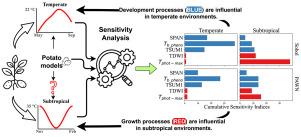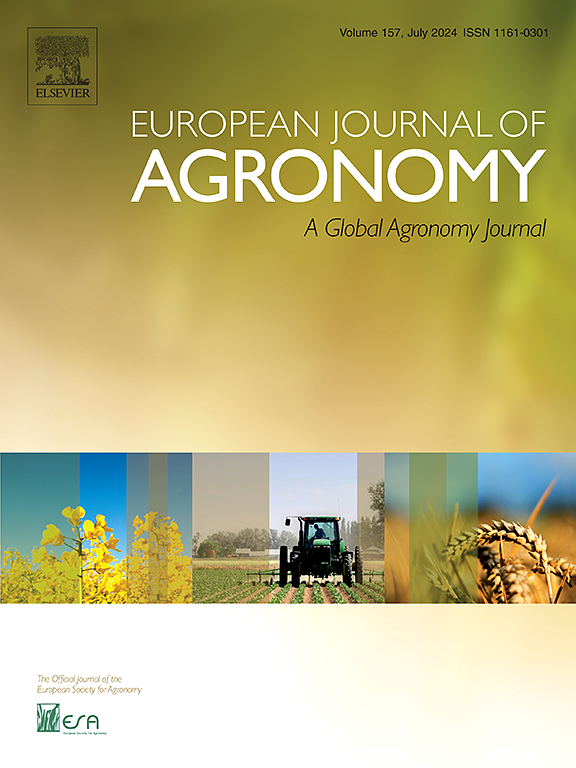wofost -马铃薯在温带和亚热带环境下的时间敏感性分析
IF 5.5
1区 农林科学
Q1 AGRONOMY
引用次数: 0
摘要
马铃薯是全球第四大粮食作物,越来越多地种植在亚热带地区,印度现在是第二大生产国。由于气候变化,亚热带气候将受到热浪和干旱加剧的影响。作物生长模型(cgm)是预测和制定作物气候适应战略的关键工具,世界粮食研究(WOFOST)是在这方面使用最广泛的模型之一。然而,WOFOST-Potato的开发主要基于在温和或最佳天气条件下获得的数据,这阻碍了其在相对较热的亚热带气候(如印度)的预测能力。亚热带地区的试验可以扩大WOFOST的适用性。比较在温带和亚热带气候下主导作物生长的WOFOST过程,可以为改善WOFOST和确定关键的气候适应性状提供见解。系统敏感性分析(SA)在这方面很有用。本研究采用三种SA方法(local SA, Sobol和PAWN)对WOFOST-Potato进行分析,以确定在高温条件下模拟马铃薯物候和生长的关键温度相关过程。我们选择了两个气候对比鲜明的地点,即荷兰(温带)和印度(亚热带)。通过计算随时间变化的参数灵敏度,我们说明了主导过程在整个生长季节都在变化。两个地点的灵敏度模式根本不同。在荷兰,叶面积指数(LAI)和块茎产量(TWSO)对发育相关参数敏感,而在印度,叶面积指数(LAI)和产量对生长相关参数主要敏感。研究发现,随时间变化的SA能够捕捉到WOFOST-Potato的季节动态,并且比季末SA更能识别亚热带环境下的关键参数。在全局敏感性分析结果的基础上,我们发现局部敏感性分析对于捕获由关键参数驱动的模型行为仍然具有附加价值。基于我们的研究结果,我们认为各种时间相关SA方法的组合为识别不同环境下wofost -马铃薯的关键过程提供了一种可靠的方法。我们的研究结果表明,亚热带环境下光合作用与温度之间的关系可能需要额外的关注来模拟马铃薯生产。本文章由计算机程序翻译,如有差异,请以英文原文为准。

Time-dependent sensitivity analysis of WOFOST-Potato for temperate and subtropical environments
Potato, the fourth most important food crop globally, is increasingly grown in subtropical regions, and India is now the second largest producer. Subtropical climates will be affected by the intensified occurrence of heatwaves and droughts due to climate change. Crop growth models (CGMs) are critical tools to predict and build strategies for crop climate adaptation, with the World Food Studies (WOFOST) being among the most widely used in this regard. However, WOFOST-Potato was developed based mainly on data acquired under mild or optimal weather conditions, which impedes its predictive ability in relatively hotter subtropical climates such as India. Experiments from subtropical regions can be used to broaden WOFOST applicability. Comparing the WOFOST processes that dominate crop growth during the growing season in temperate versus subtropical climates may provide insights to improve WOFOST and identify key climate adaptive traits. Systematic sensitivity analysis (SA) is useful for this purpose. Here, we applied three SA methods (local SA, Sobol and PAWN) to WOFOST-Potato to identify the key temperature-related processes responsible for simulating potato phenology and growth under hot conditions. We selected two locations with contrasting climates, i.e. the Netherlands (temperate) and India (subtropical). By computing time-dependent parameter sensitivities, we illustrate that the dominant processes change throughout the growing season. Sensitivity patterns differ fundamentally between the two locations. In the Netherlands, the leaf area index (LAI) and tuber yield (TWSO) were sensitive to development-related parameters, whereas in India, LAI and yield were predominantly sensitive to growth-related parameters. We find that time-dependent SA is able to capture the seasonal dynamics of WOFOST-Potato, and it is more insightful than the end-of-season SA to identify key parameters in subtropical environments. Building upon the global sensitivity analysis findings, we find that local sensitivity analysis still has added value to capture model behaviours driven by critical parameters. Based on our results, we argue that a combination of various time-dependent SA methods provides a robust approach to identifying the key processes of WOFOST-Potato in different environments. Our results indicate that the relationship between photosynthesis and temperatures in subtropical environments may need extra attention for modelling potato production.
求助全文
通过发布文献求助,成功后即可免费获取论文全文。
去求助
来源期刊

European Journal of Agronomy
农林科学-农艺学
CiteScore
8.30
自引率
7.70%
发文量
187
审稿时长
4.5 months
期刊介绍:
The European Journal of Agronomy, the official journal of the European Society for Agronomy, publishes original research papers reporting experimental and theoretical contributions to field-based agronomy and crop science. The journal will consider research at the field level for agricultural, horticultural and tree crops, that uses comprehensive and explanatory approaches. The EJA covers the following topics:
crop physiology
crop production and management including irrigation, fertilization and soil management
agroclimatology and modelling
plant-soil relationships
crop quality and post-harvest physiology
farming and cropping systems
agroecosystems and the environment
crop-weed interactions and management
organic farming
horticultural crops
papers from the European Society for Agronomy bi-annual meetings
In determining the suitability of submitted articles for publication, particular scrutiny is placed on the degree of novelty and significance of the research and the extent to which it adds to existing knowledge in agronomy.
 求助内容:
求助内容: 应助结果提醒方式:
应助结果提醒方式:


